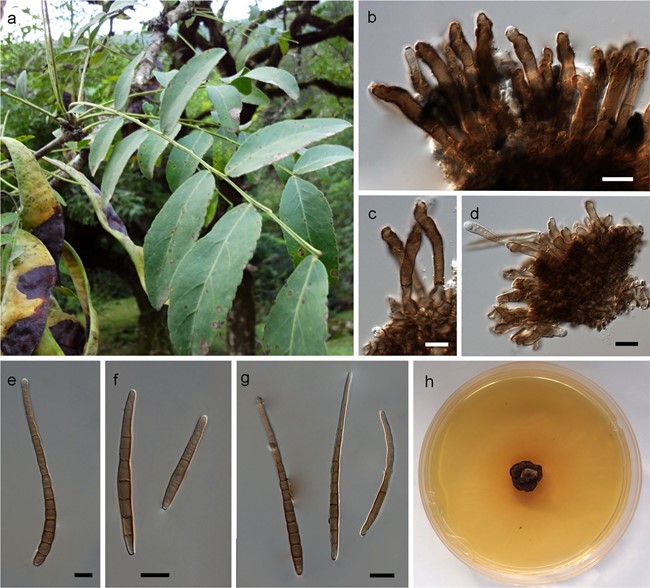Prathigadoides gleditsiae-caspicae M. Bakhshi, Zare & U. Braun sp. nov. Figure 3
MycoBank number: MB 840244; Index Fungorum number: IF 840244; Facesoffungi number: FoF 15722
Etymology. Epithet derived from the host of this fungus,Gleditsia caspica.
Holotype. Iran: Guilan Province, Talesh, Kishonben, on Gleditsia caspica L. (Fabaceae), 12 October 2012, M. Bakhshi (IRAN 16460F).
Ex-type strain: CBS 136121. GenBank: ACT = MZ427665; CAL = MZ427673; HIS = MZ427681; TEF1-α = MZ427692.
Description in planta: Leaf spots amphigenous, circular to subcircular, 1–4 mm diam., gray in center, with brown margin, occasionally with shot holes in the centers. Mycelium internal. Stromata well-developed, substomatal to intraepidermal, semi-immersed, brown, 25–75 μm diam. Caespituli amphigenous. Conidiophores aggregated in loose to dense fascicles, erumpent through the cuticle or emerging through stomata, medium to dark brown, finely roughened, 0–3-septate, unbranched, straight, slightly curved or geniculate-sinuous, subcylindrical, wall thickened, regular in width, (25–)40–55(–80) × (3.5–)4–5 μm. Conidiogenous cells integrated, terminal, medium brown, finely roughened, polyblastic, proliferating sympodially, with conidiogenous loci thickened, darkened, protuberant and somewhat refractive, located at the apex and on shoulders formed by sympodial proliferation, 2–3.5 μm diam. Conidia solitary, brown, subcylindrical to obclavate, usually rostrate, straight to gently curved, smooth to rough-walled, wall thickened, apex subobtuse to obtuse, base truncated to short obconically truncated, (4–)10–16-septate, occasionally constricted at the septa, (42–)65–76(–110) × (4.5–)5.5–6 μm; hila thickened, darkened and refractive, 1–2 μm diam.
Cultural characteristics: Colonies on MEA, surface raised, folded, dark brown-gray, with sparse aerial mycelium and irregular margin, reverse dark brown, reaching 7 mm after 20 days at 25 °C.
Additional material examined: Iran: Guilan Province, Gourab Zarmikh, N 37° 18′ 02ʺ, E 49° 12′ 39ʺ, on Gleditsia caspica, 7 August 2019, M. Bakhshi (IRAN 18053F, IRAN 4110C, IRAN 4111C); Guilan Province, Talesh, Kishonben, on Gleditsia caspica, October 2020, M. Bakhshi (P 829).
Notes: The cercosporoid fungus found in Iran on the endemic Gleditsia caspica, distributed in a small area near the southern coast of the Caspian Sea, proved to belong to a clade of its own, distinct from all other clades within the Mycosphaerellaceae, which reflects a new undescribed genus. The type species of the new genus is morphologically close to Prathigada condensata (Ellis & Kellerm.) U. Braun [≡ Cercospora condensata Ellis & Kellerm, Passalora condensata (Ellis & Kellerm.) U. Braun] on the North American Gleditsia triacanthos L., but differs in having finely verrucu- lose conidiophores with wider conidiogenous loci, 2–3.5 µm diam., and shorter conidia, (42–)65–76(–110) µm long, with numerous dense septa [(4–)10–16], and narrower hila, 1–2 µm diam. [versus, smooth conidiophores with narrower loci, 1.5–2.5 µm diam., and longer conidia, 40–150 µm long, with fewer, more spaced septa, 4–12, and larger hila, 2–2.5 µm diam. (Braun et al. 2013)]. Furthermore, the two hosts species, G. caspica and G. triacanthos, are geographically and phylogenetically clearly distinct. Gleditsia caspica belongs to the Asian G. japonica clade, which is distantly related to the G. triacanthos clade (Schnabel et al. 2003). In spite of the strong morphological similarity between the new species from Iran and species previously assigned to Prathigada, the latter genus is not available for the fungus on Gleditsia caspica. Based on phylogenetic examinations of the type species of Prathigada, P. cratevae (Syd. & P. Syd.) Subram., this genus was reduced to synonymy with Pseudocercospora (Braun et al. 2013). The conidiogenous loci and hila in the type species of Prathigada are conspicuous by being rigid and refractive, falling into the morpho- logical variation of Pseudocercospora spp., but they are not truly thickened. The loci in Cercospora condensata are thickened and somewhat similar to those of Prathigadoides gleditsiae-caspicae, suggesting that the two species might be congeneric. However, the clarification of this question requires results of phylogenetic analyses of C. condensata.
In any case, the North American cercosporoid species on G. triacanthos neither pertain to Cercospora nor to Passa- lora in the current sense and circumscription (Videira et al. 2017).

Fig. 3 Prathigadoides gleditsiae-caspicae (IRAN 16460F). a Leaf spot symptoms on Gleditsia caspica. b–d Fasciculate conidiophores. e–g
Conidia. h Culture on MEA. Scale bars = 10 μm
